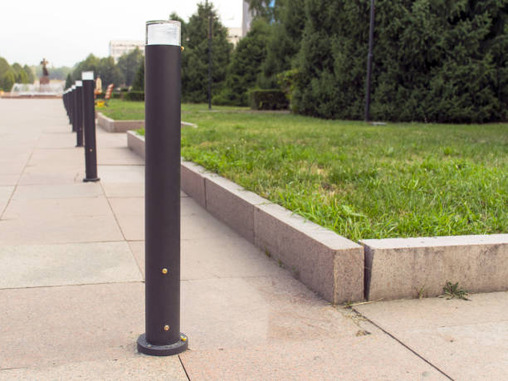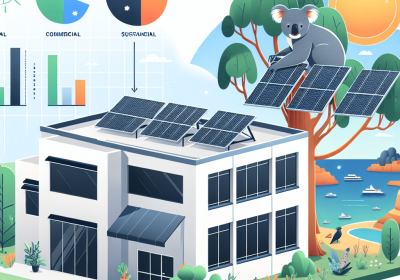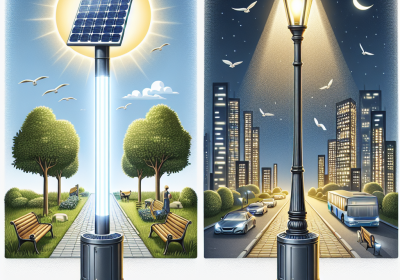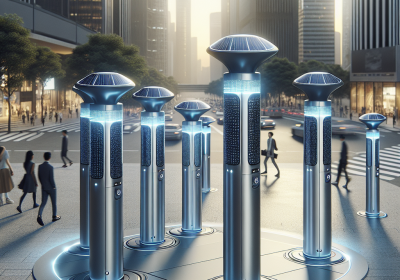Innovation in Illumination: The Latest Technologies in Solar Bollard Design
In the vast tapestry of outdoor lighting, where the stars twinkle above and the ground beneath craves illumination, solar bollard lights stand as silent sentinels, blending functionality with sustainability. But what drives the evolution of these humble yet powerful fixtures? How do they weave innovation into their luminous fabric, and what promises do they hold for the future of outdoor illumination?
Overview of Solar Bollard Lights:
Picture this: slender, unassuming pillars scattered across pathways, gardens, and parking lots, harnessing the sun’s energy by day and casting a gentle glow by night. These are solar bollard lights, compact beacons that illuminate outdoor spaces without the need for grid electricity.

Importance of Innovation in Outdoor Lighting and Energy Sustainability: As our world grapples with pressing environmental concerns, the quest for sustainable lighting solutions becomes paramount. Solar bollard lights not only offer practical illumination but also symbolize our commitment to harnessing renewable energy sources.
Evolution of Solar Bollard Lights
Brief History: The story of solar bollard lights traces back to the early experiments with solar power in the 19th century. However, it wasn’t until the late 20th century that advancements in photovoltaic technology paved the way for practical applications in outdoor lighting.
Key Developments: Over the years, solar bollard lights have undergone a remarkable transformation. From simple designs with limited functionality to sophisticated systems equipped with smart features, their evolution mirrors the relentless march of innovation in renewable energy technology.
Latest Technologies in Solar Bollard Design
Advanced Photovoltaic Cells: Imagine solar cells so efficient that they could capture the faintest glimmer of sunlight and convert it into electricity with unprecedented precision. With advancements in photovoltaic technology, this vision is becoming a reality. New solar cell technologies, such as multi-junction cells and perovskite solar cells, are revolutionizing energy efficiency and light output, ensuring that solar bollard lights shine brighter and longer than ever before.
Improved Battery Technologies: The Achilles’ heel of solar-powered devices has long been their reliance on bulky, short-lived batteries. However, recent advancements in battery technology, particularly the widespread adoption of lithium-ion batteries, have transformed the landscape. With their longer life spans and superior performance in diverse climates, these batteries provide the backbone for reliable solar bollard lighting systems.
Smart Features: What if your solar bollard lights could do more than just illuminate your path? What if they could sense your presence, adjust their brightness accordingly, and communicate with each other to create seamless lighting experiences? With the integration of sensors and IoT connectivity, these futuristic scenarios are becoming a reality. Smart solar bollard lights offer unparalleled usability and control, empowering users to tailor their lighting environments to their exact preferences.
Materials and Construction: Beyond technological wizardry, innovation in solar bollard design extends to materials and construction techniques. From the use of recycled materials to anti-corrosive treatments, manufacturers are prioritizing durability and aesthetics without compromising on sustainability. Design trends favor sleek, minimalist forms that seamlessly blend into modern landscapes, creating harmonious visual compositions that delight the eye and nurture the soul.

Environmental Impact and Sustainability
Reducing Carbon Footprints: Every ray of sunshine captured by a solar bollard light represents a step towards reducing our carbon footprint. By harnessing renewable energy sources, these fixtures help mitigate the environmental impact of traditional lighting systems, contributing to a greener, more sustainable future.
Contributions to Green Building Certifications: In the realm of sustainable design, solar bollard lights play a crucial role in achieving green building certifications such as LEED and BREEAM. Their energy-efficient operation and minimal environmental impact make them indispensable assets in the quest for eco-friendly urban and rural development.
Case Studies
Examples of Recent Installations: From bustling city streets to tranquil parks, solar bollard lights have found their way into a diverse array of environments. Recent installations showcase their versatility and impact, illuminating pathways, enhancing safety, and transforming public spaces into beacons of light and warmth.
Feedback from Users: The verdict from users is unanimous: solar bollard lights not only meet but exceed expectations. Their reliability, energy efficiency, and low maintenance requirements have won praise from communities around the world, reaffirming their status as indispensable assets in outdoor lighting.
Challenges and Limitations
Technical Challenges: Despite their myriad benefits, solar bollard lights still face technical challenges, chief among them being variability in sunlight availability and efficiency limitations during cloudy days or winter months. Addressing these challenges requires ongoing innovation and refinement of solar technology.
Practical Limitations: In addition to technical challenges, practical considerations such as installation complexity and initial costs can pose barriers to widespread adoption of solar bollard lights. However, as technology continues to improve and costs decrease, these limitations are gradually being overcome.
Future Outlook
Predictions for Advancements: The future of solar bollard technology holds exciting possibilities. From advancements in energy storage and efficiency to the integration of emerging technologies like AI and machine learning, the stage is set for a new era of innovation in outdoor lighting.
In the ever-evolving landscape of outdoor illumination, solar bollard lights stand as beacons of innovation and sustainability. As we navigate the complexities of a changing world, let us embrace these technologies with open arms, weaving them into the fabric of our urban and rural environments to create brighter, greener, and more vibrant spaces for generations to come.
FAQs
Q: Are solar bollard lights suitable for all climates? A: While solar bollard lights can function in most climates, their efficiency may vary depending on factors such as sunlight availability and temperature extremes. Advances in battery technology have improved performance in diverse conditions, but it’s essential to consider local climate conditions when planning installations.
Q: How long do solar bollard lights typically last? A: The lifespan of solar bollard lights can vary depending on factors such as battery quality and maintenance practices. However, with proper care, modern solar bollard lights can last anywhere from 5 to 15 years or more.
Q: Can solar bollard lights be installed in remote locations without access to grid electricity? A: Yes, one of the primary advantages of solar bollard lights is their ability to operate independently of grid electricity. This makes them ideal for remote locations where traditional lighting infrastructure may be impractical or cost-prohibitive.
Q: How do smart features enhance the usability of solar bollard lights? A: Smart features such as motion sensors and IoT connectivity allow solar bollard lights to adapt to their surroundings, adjusting brightness levels based on ambient light conditions or detecting movement to enhance safety and security. These features offer greater flexibility and control over lighting environments, optimizing energy efficiency and user experience.
References:
https://orcasolarlighting.com.au/solar-bollard-lighting
Read more about commercial solar street lights
Illuminating the Path: The Rise of Commercial Solar Bollards in Australian Landscapes
Eco-Friendly and Efficient: How Solar Bollards Are Shaping Australia’s Green Cities
Cost Analysis: The Long-Term Savings of Solar Bollards Over Traditional Lighting Solutions
The Role of Solar Bollards in Australia’s Varied Climates
Regulatory Insights: Compliance and Standards for Installing Solar Bollards in Australia
Public Perception and Acceptance: Community Responses to Solar Bollards in Urban Areas
The Future of Outdoor Lighting: Predictions for Solar Bollards in the Next Decade








